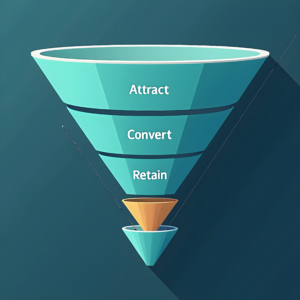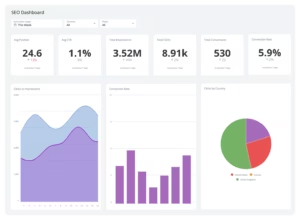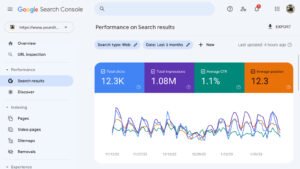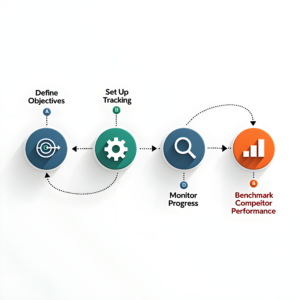You’ve worked hard on your website’s SEO, optimizing content, building backlinks, and tweaking keywords, but how do you know it’s paying off?
Understanding how to measure SEO performance and results is the key to turning all that effort into tangible growth for your business.
Think of SEO like a workout plan for your website. You wouldn’t hit the gym daily without tracking your progress, right? The same goes for SEO—measuring it ensures your efforts aren’t wasted on strategies that don’t work.
Measuring SEO performance is essential because it’s the only way to see if your strategies are moving the needle. Imagine spending months trying to rank for certain keywords only to find out they don’t drive any meaningful traffic.
When you track performance metrics, you can pinpoint what’s working, what’s not, and what needs a little extra love. Plus, it keeps you on top of trends, so you can adapt quickly if something changes because let’s face it, search engines like to keep us on our toes!
Now, here’s where it gets even more interesting- SEO metrics are not one-size-fits-all. Aligning your metrics with your business goals is where the magic happens.
Are you looking to increase brand awareness? Then organic traffic might be your go-to metric. Hoping to drive sales? Focus on conversion rates and ROI.
When your SEO efforts directly support your business goals, it’s like giving your marketing strategy a GPS. You know exactly where you’re going and how close you are to getting there.
Measuring SEO isn’t just about numbers—it’s about making smarter decisions and growing your business strategically. Stick around, and we’ll show you exactly how to measure SEO performance and results like a pro!

Key Performance Indicators (KPIs) for SEO:
When it comes to how to measure SEO performance and results, KPIs are your best friends. These metrics help you understand if your SEO efforts are driving meaningful impact. Let’s dive into the essentials!
- Organic Traffic: The bread and butter of SEO. It shows how many people are landing on your website via search engines. The more organic traffic you have, the more visible your site is to potential customers. Tools like Google Analytics make tracking this a breeze—just head to the “Acquisition” tab to see where your traffic is coming from.
- Keyword Rankings: This is a great way to track your progress. Are your targeted keywords climbing the ladder in search results? Tools like SEMrush, Ahrefs, Google Search Console or my personal favourite Wincher help you monitor ranking changes and identify opportunities.
- Click-Through Rate (CTR): Measures how many people click your link after seeing it in search results. Strong meta titles and descriptions boost your CTR, so don’t skip optimizing them. Google Search Console provides detailed CTR insights to guide your tweaks.
- Bounce Rate and Dwell Time: This reveal how engaging your site is. A high bounce rate or short dwell time signals users aren’t sticking around. Tools like Google Analytics let you spot underperforming pages and make improvements.
- Domain Authority (DA) and Page Authority (PA): DA and PA impact how search engines perceive your website. Higher scores mean better chances of ranking well. Use Moz or Ahrefs to keep tabs on these metrics and plan your link-building strategies.
- Conversions and ROI: Last but definately not the least! This show the real impact of SEO on your business. Google Analytics tracks goal completions, ecommerce sales, and revenue—giving you clear proof of your SEO success.

By focusing on these KPIs, you can make smarter decisions and truly measure the value of your SEO efforts!
Tools to Measure SEO Performance
If you’re serious about learning how to measure SEO performance and results, the right tools are your secret weapon. These tools give you valuable insights, make tracking metrics a breeze, and help you fine-tune your SEO strategy. Let’s take a closer look at some must-haves!
1. Google Search Console

Google Search Console is like your website’s personal fitness tracker for SEO. It shows how Google views your site and highlights areas to improve. Want to know which keywords bring the most clicks or spot technical issues like broken links? This tool has your back. Plus, you’ll get insights into your site’s performance, mobile usability, and indexing status—all for free!
2. Google Analytics
Google Analytics (GA4) is the ultimate powerhouse for monitoring key metrics. You can track organic traffic, analyze conversion rates, and even see where your visitors come from. The “Acquisition” tab is your go-to spot to uncover traffic sources, while the “Conversions” tab reveals how SEO efforts contribute to sales and leads.
3. Third-party tools
For deeper insights, third-party tools like SEMrush, Ahrefs, Moz, and Screaming Frog step up the game.
SEMrush and Ahrefs are excellent for keyword research, backlink analysis, and monitoring your competitors. I
f you’re curious about your website’s domain authority or link-building potential, Moz is a reliable choice.
And for those technical SEO audits, Screaming Frog acts like a detective, crawling your site to uncover issues like duplicate content or missing meta tags.
Each of these tools brings unique strengths to your SEO toolkit. Using them together gives you a complete picture of your website’s performance and helps you make smarter, data-driven decisions.
The best part? You don’t have to be a tech wizard to use them—they’re designed to help everyone, including you, succeed at SEO!
Steps to Measure SEO Results
If you’re wondering how to measure SEO performance and results, the process doesn’t have to feel overwhelming. By breaking it into steps, you can stay on track and clearly see what’s working. Here’s a simple roadmap to follow!

Step 1: Define Objectives and Goals
Start by asking yourself: What do I want to achieve with SEO? Are you aiming for more brand awareness, generating leads, or boosting online sales?
Clear goals give you a sense of direction and ensure your SEO strategy aligns with your overall business objectives. For example, if lead generation is your focus, tracking form submissions and email sign-ups should top your list.
Step 2: Set Up Tracking Mechanisms
Now, it’s time to set up tools like Google Analytics and Google Search Console to gather your data. Google Analytics helps you monitor traffic, conversions, and user behavior, while Search Console tracks keyword performance and technical health.
Linking the two tools gives you a powerhouse setup for tracking all the essentials.
Learn how to link Search Console and Analytics .
Step 3: Regularly Monitor and Document Progress
Make it a habit to check your SEO metrics regularly. Use dashboards and reports to track key metrics like organic traffic, keyword rankings, and click-through rates. Documenting this data over time helps you spot trends and adjust your strategy for better results.
Step 4: Analyze Competitor Performance
Your competitors can be a goldmine of insights! Use tools like SEMrush or Ahrefs to analyze their performance and find benchmarks for your industry. Spotting their strengths and weaknesses can help you refine your own SEO efforts.
With these steps, you’ll not only understand how to measure SEO performance and results but also have the tools to improve continuously. Remember, SEO isn’t a one-time task—it’s a journey, and consistent tracking ensures you stay on the right path!
Common Challenges in Measuring SEO Performance

When diving into how to measure SEO performance and results, you’ll quickly realize it’s not always smooth sailing. While SEO can deliver incredible benefits, some challenges can make measuring your success feel like solving a puzzle.
Here are a few common roadblocks and how to navigate them.
The Long-Term Nature of SEO Results
Patience is a virtue especially in SEO. Unlike paid ads that yield instant results, SEO takes time to show its magic. Rankings, traffic, and conversions often improve gradually over months, not days.
This long-term nature can make it hard to stay motivated. But remember, SEO is an investment, not a quick fix, and the rewards are worth the wait!
Attribution Difficulties (Organic vs. Paid)
One of the trickiest parts of measuring SEO is knowing where your results come from. Was it that viral social media post, the paid ad campaign, or your organic efforts?
Attribution challenges can blur the lines. Google Analytics and tools like UTM tracking can help you separate organic traffic from other sources, giving you clearer insights.
Algorithm Updates Impacting Performance
Just when you think you’ve nailed your SEO strategy, an algorithm update might throw a curveball. Google’s regular updates can shake up rankings and impact your hard-earned traffic.
While these changes can feel frustrating, they’re also opportunities to adapt and improve. Keeping an eye on updates and staying flexible ensures you can tackle them head-on.
Despite these challenges, understanding how to measure SEO performance and results is entirely doable with the right mindset and tools. The key is to stay consistent, keep learning, and be ready to pivot when needed. After all, the road to SEO success is a marathon, not a sprint!
Reporting SEO Performance
When it’s time to show off your hard work, knowing how to measure SEO performance and results is only half the job. The other half? Presenting it in a way that keeps your stakeholders engaged and informed.
Let’s explore how to create reports that impress!

How to Create Easy-to-Understand SEO Reports
Your SEO report doesn’t have to be a data dump. Keep it simple and focus on what matters most to your audience. Start by outlining key metrics like organic traffic, keyword rankings, and conversions.
Tools like Looker Studio or SEMrush can help you create visually appealing reports with charts and graphs that tell a clear story.
Stick to the essentials: What goals were set? What progress has been made? Use plain language to explain any technical terms or trends. Remember, not everyone loves jargon as much as you do!
Highlighting Key Wins and Areas for Improvement
Stakeholders want to hear about wins, so don’t shy away from celebrating successes. Did organic traffic grow by 20%? Did a high-priority keyword hit page one? Highlight these wins front and center. It shows the impact of your SEO efforts and builds trust.
But don’t ignore the challenges. Point out areas for improvement and share actionable solutions. For example, if bounce rates are high, propose optimizing content or improving page speed. By pairing problems with solutions, you’ll show stakeholders you’re proactive and ready to adapt.
Clear, engaging reports help you communicate the value of your SEO work and keep everyone aligned. With the right approach, reporting on how to measure SEO performance and results can feel less like a chore and more like sharing a success story!
Conclusion

Mastering how to measure SEO performance and results is more than just crunching numbers it’s about unlocking the full potential of your strategy.
Consistent tracking and analysis are the lifeblood of SEO. Without them, it’s like trying to navigate a new city without a map. Regularly monitoring your progress ensures you stay on course and adapt to changing trends.
Remember, SEO isn’t a one-and-done task; it’s a journey. From organic traffic to keyword rankings and conversions, each metric tells a part of your success story.
By tracking these indicators, you’ll gain valuable insights into what’s working, what’s not, and where to tweak your efforts for even better results.
The key to long-term success? Data-driven decision-making. Don’t guess let the numbers guide you. When you use data to back your decisions, you’re not just reacting to trends; you’re shaping them.
Whether it’s optimizing content for higher engagement or adjusting strategies to counter a competitor’s move, your choices will be smarter and more impactful.
At the end of the day, measuring SEO performance is less about perfection and more about progress. Celebrate small wins, learn from challenges, and stay committed to growth.
With a solid understanding of how to measure SEO performance and results, you’ll be equipped to turn your SEO efforts into measurable business success. So, keep analyzing, keep adapting, and watch your SEO strategy thrive!
What is the only way to track SEO results?
The only way to effectively track SEO results is by using tools like Google Analytics, Google Search Console, and third-party software. These platforms help you measure organic traffic, keyword rankings, conversions, and other key SEO metrics.
What are KPIs for SEO?
KPIs for SEO (Key Performance Indicators) are metrics that track your SEO success. Common KPIs include organic traffic, keyword rankings, click-through rate (CTR), bounce rate, dwell time, and conversions. They help you measure SEO performance and results in alignment with your business goals.
How to present SEO results?
Present SEO results through easy-to-understand reports highlighting organic traffic growth, keyword ranking improvements, and conversion rates. Use visuals like charts and graphs, and focus on actionable insights to show progress and areas for improvement.
How to calculate SEO score?
Calculate your SEO score by analyzing factors like site speed, mobile-friendliness, keyword optimization, and backlink quality. Tools like SEMrush, Ahrefs, and Moz provide detailed reports to help measure SEO performance and results.
How do I know if my SEO is working?
You know your SEO is working when you see improvements in organic traffic, higher keyword rankings, increased conversions, and better engagement metrics like lower bounce rates. Regular monitoring with tools like Google Analytics is essential.
Ready to take your SEO to the next level?





